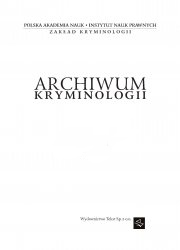HISZPAŃSKA USTAWA O PRZEMOCY ZE WZGLĘDU NA PŁEĆ. ANALIZA KRYMINALNO-POLITYCZNA
A Criminal and Political Analysis of The Spanish Gender Violence Law
Author(s): Magdalena GrzybSubject(s): Law, Constitution, Jurisprudence, Criminal Law
Published by: Instytut Nauk Prawnych PAN
Keywords: przemoc; płeć; ofiara przemocy; kryminologia;
Summary/Abstract: The Spanish Comprehensive Protection Measures against Gender Violence of 28 December 2004 (Ley Organica 1/2004, de 28 de diciembre, de Medidas de Protección Integral contra la Violencia de Género) is considered one of the most advanced and ground-breaking legal acts designed to counter gender violence and is often viewed as a model piece of legislation to be emulated by other countries. The characteristic feature of this law is the introduction of criminal-law protection for women experiencing violence from their partner.Although the Spanish law has been praised in the international arena, it has definitely elicited mixed feelings in Spain itself. It seems a paradox that one of the few laws passed in recent decades with the full consensus of all political parties instantly became one of the most criticized and subjected to judgment. Even before it entered into force, the law encountered significant criticism from the Spanish judiciary, while its application in practice has earned it further opponents and critics – nearly all of them engaged social stakeholders: feminists, legal theorists, criminologists, and victims of violence themselves. Some of the charges probably do not stem from the faulty operation or application of the law as such, but from the dashed hopes and disappointed expectations, grounded in the naïve belief that the new law would quickly transform society and eradicate gender violence.The aim of the article is to sum up ten years of the gender violence law in Spain. The first part outlines the origins of LO 1/2004, its historical and political background, including the fall of Franco’s dictatorship and the later socialist government whose rule led to increased interest in gender equality and the introduction of measures to counter all instances of discrimination in addition to raising public awareness of violence against women starting in the 1990s.The second part discusses the content of LO 1/2004 and explains why the Spanish legislators adopted the gender violence framework (instead of the neutral ‘domestic violence’ model, as referenced in Polish and other national legislations), which recognises that women are disproportionally more prone to certain forms of violence, particularly on the part of relatives and partners, which is due to structural inequality and centuries-old historical discrimination of women. Gender violence is an infringement of human and women’s rights and, as such, should be combated. The ‘gender violence’ approach is also currently the dominant perspective in international human rights discourse and international documents. The third part discusses controversies that have arisen in connection with the law and examines the main charges put against it. The introduction of LO 1/2004 has raised doubts as to its being consistent with the constitutional principle of equality before the law. The Spanish Constitutional Tribunal decided this issue in favour of the law in 2008. The law might also make the situation of certain victims more complicated, as it imposes very strict and punitive solutions, thus stripping them of subjectivity. The law has moreover encountered strong opposition from the judiciary itself, which wasn’t pleased with it from the very beginning. Finally, the Author examines various figures related to gender violence and how they have evolved over the ten years since the law entered into force.Part four is devoted to the amendment of Spanish criminal law in 2015 to take account of gender violence, and discusses the direction of legislative and criminal/political changes.The final part consists of a summary and an attempt to provide a comprehensive assessment of the law since it was passed.
Journal: Archiwum Kryminologii
- Issue Year: 2017
- Issue No: XXXIX
- Page Range: 339-368
- Page Count: 30
- Language: Polish

